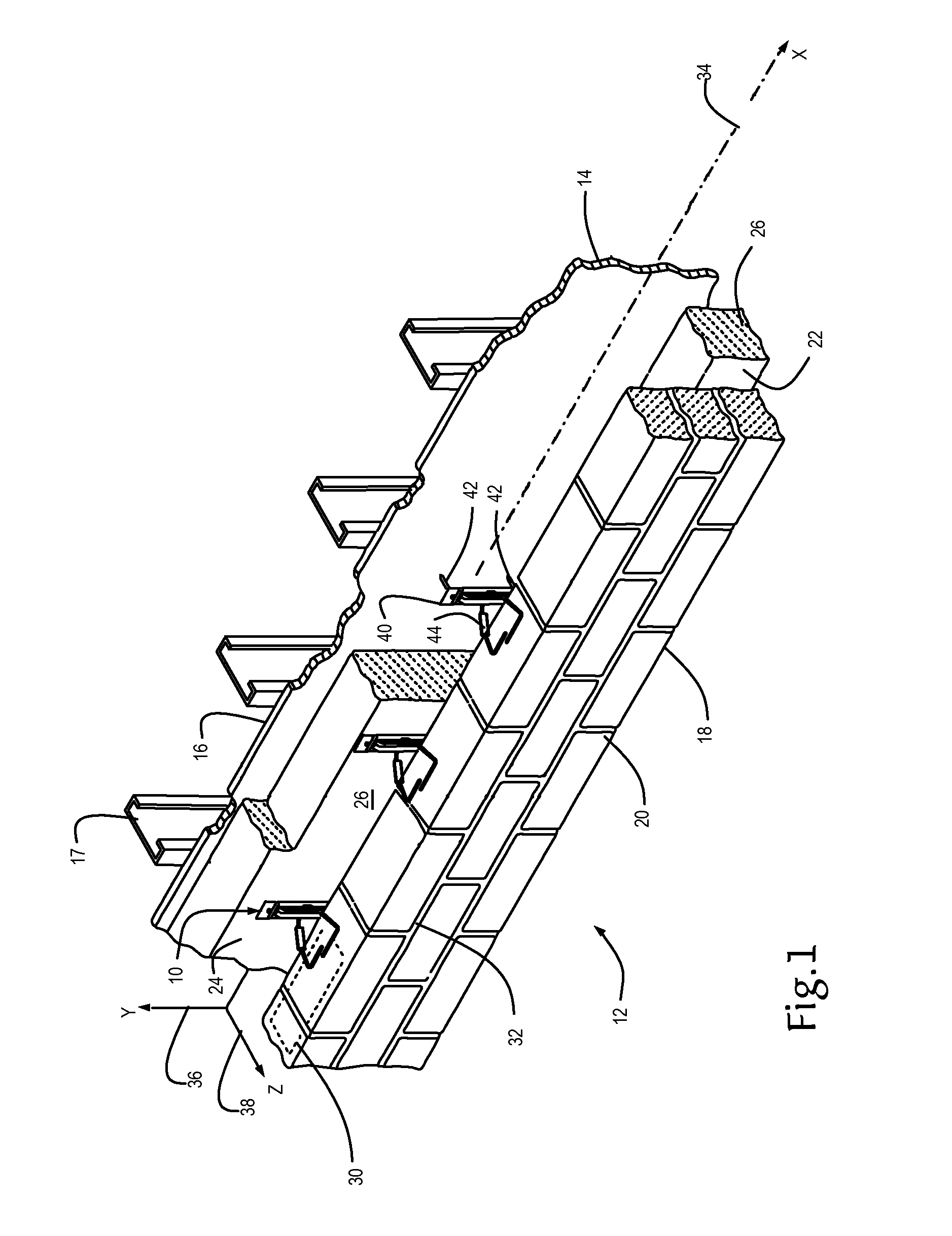High-strength vertically compressed veneer tie anchoring systems utilizing and the same
a vertical compression and anchoring system technology, applied in the direction of walls, building components, structural elements, etc., can solve the problems of insufficient insulation integrity of the system, frequent failure of the anchoring system, and hampered installations, etc., to achieve high insulation value, reduce the risk of harmed installations, and reduce the effect of tensile for
- Summary
- Abstract
- Description
- Claims
- Application Information
AI Technical Summary
Benefits of technology
Problems solved by technology
Method used
Image
Examples
first embodiment
[0063]Referring now to FIGS. 1 through 5, and 10, the anchoring system hereof including a high-strength vertically compressed or ribbon veneer tie of this invention is shown and is referred to generally by the number 10. A cavity wall structure 12 is shown having an inner wythe or drywall backup 14 with sheetrock or wallboard 16 mounted on metal framing members or columns 17 and an outer wythe or facing wall 18 of brick 20 construction. Inner wythes constructed of masonry materials or wood framing are also applicable. Between the inner wythe 14 and the outer wythe 18, a cavity 22 is formed. The outer wythe 18 has a facial plane or cavity surface 24 in the cavity 22.
[0064]Successive bed joints 30 and 32 are substantially planar and horizontally disposed and, in accord with current building standards, are 0.375-inch (approx.) in height. Selective ones of bed joints 30 and 32, which are formed between courses of bricks 20, are constructed to receive therewithin the insertion portion of...
second embodiment
[0074]Referring now to FIGS. 6 through 10, the anchoring system is shown and is referred to generally by the number 110. A cavity wall structure 112 is shown having an inner wythe or masonry backup 114 with rigid insulation thereon 126 and an outer wythe or veneer 118 of brick 120 construction. Between the inner wythe 114 and the outer wythe 118, a cavity 122 is formed. The outer wythe 118 has a facial plane or cavity surface 124 in the cavity 122.
[0075]Successive bed joints 130 and 132 are substantially planar and horizontally disposed in the outer wythe 118 and, in accord with current building standards, are 0.375-inch (approx.) in height. Selective ones of bed joints 130 and 132, which are formed between courses of bricks 120, are constructed to receive therewithin the insertion portion of the veneer anchor hereof. Being surface mounted in the inner wythe 114, the wall anchor 140 is supported thereby and, as described in greater detail herein below, is configured to minimize air ...
PUM
 Login to View More
Login to View More Abstract
Description
Claims
Application Information
 Login to View More
Login to View More - R&D
- Intellectual Property
- Life Sciences
- Materials
- Tech Scout
- Unparalleled Data Quality
- Higher Quality Content
- 60% Fewer Hallucinations
Browse by: Latest US Patents, China's latest patents, Technical Efficacy Thesaurus, Application Domain, Technology Topic, Popular Technical Reports.
© 2025 PatSnap. All rights reserved.Legal|Privacy policy|Modern Slavery Act Transparency Statement|Sitemap|About US| Contact US: help@patsnap.com



